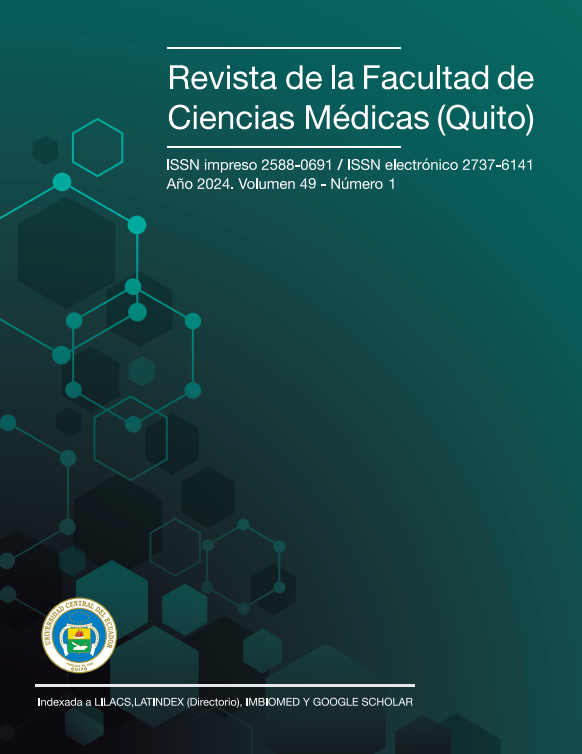Pruritus and Cutaneous Lesions: Granuloma Annulare vs. Mycosis Fungoides in a Patient with Comorbidities. A Case Report
DOI:
https://doi.org/10.29166/rfcmq.v49i1.5985Keywords:
pruritus, granuloma annulare, mycosis fungoidesAbstract
Introduction: Pruritus is a common symptom in dermatological practice. Affecting patients with a wide range of cutaneous and systemic diseases. It can be caused by cutaneous disorders, systemic diseases, neurological disorders, psychological disorders, medications, among others. When assessing individuals with pruritus and cutaneous lesions, it is essential to consider mycosis fungoides and granuloma annulare as noteworthy differential diagnoses.
Case presentation: A 51-year-old female patient exhibited symptoms of pruritus and two occurrences of pruritic skin lesions. Accompanied by a low-grade fever measuring 37.7 ºC, as well as asthenia and myalgia. Physical examination revealed two rounded plaques with erythematous borders and multiple non-confluent papular lesions.
Discussion: Differentiating between mycosis fungoides and granuloma annulare can be challenging due to the similarities in their clinical presentations. However, performing a biopsy is essential to reach a definitive diagnosis.
Conclusions: A biopsy is being suggested for the front part of the left lower limb. The application of mometasone furoate twice a day for two weeks was prescribed. Subsequently, a meeting has been arranged to conduct a review and to carefully analyze the biopsy findings within thirty days.
Downloads
Metrics
References
Navarro-Triviño FJ. Prurito en dermatología. Enfermedades y su tratamiento. Parte 2. Actas Dermo-Sifiliográficas. 2023;114(7):613-26.
Ruenger T. Manuale Merck versión para el público general. Prurito - Trastornos de la piel. [Internet]. 2023 [Cited Dec 16, 2023]. Available from: https://www.merckmanuals.com/es-us/hogar/trastornos-de-la-piel/prurito-y-dermatitis/prurito
Tivoli YA, Rubenstein RM. Pruritus. J Clin Aesthet Dermatol. 2009;2(7):30-6.
saif GAB, Ericson ME, Yosipovitch G. The Itchy scalp - scratching for an explanation. Exp Dermatol. 2011;20(12):959-68.
Yang TLB, Kim BS. Pruritus in allergy and immunology. Journal of Allergy and Clinical Immunology. 2019;144(2):353-60.
Giustizieri ML, Albanesi C, Fluhr J, Gisondi P, Norgauer J, Girolomoni G. H1 histamine receptor mediates inflammatory responses in human keratinocytes. J Allergy Clin Immunol.2004;114(5):1176-82.
Gupta K, Harvima IT. Mast cell-neural interactions contribute to pain and itch. Immunol Rev.2018;282(1):168-87.
Steinhoff M, Buddenkotte J, Lerner E. Role of mast cells and basophils in pruritus - Steinhoff.Immunological Reviews. Wiley Online Library [Internet] 2018. [Cited Jan 13, 2024]. Available from: https://onlinelibrary.wiley.com/doi/10.1111/imr.12635
Triggiani M, Gentile M, Secondo A, Granata F, Oriente A, Taglialatela M, et al. Histamine induces exocytosis and IL-6 production from human lung macrophages through interaction with H1 receptors. J Immunol. 2001;166(6):4083-91.
Ling P, Ngo K, Nguyen S, Thurmond RL, Edwards JP, Karlsson L, et al. Histamine H4 receptor mediates eosinophil chemotaxis with cell shape change and adhesion molecule upregulation. Br J Pharmacol. 2004;142(6):1052.
Hirasawa N, Ohtsu H, Watanabe T, Ohuchi K. Enhancement of neutrophil infiltration in histidine decarboxylase‐deficient mice - Hirasawa .Immunology - Wiley Online Library [Internet] 2002. [Cited Jan 13, 2024]. Available from: https://onlinelibrary.wiley.com/doi/10.1046/j.1365-2567.2002.01482.x
Kabashima K, Irie H. Interleukin-31 as a Clinical Target for Pruritus Treatment. Front Med (Lausanne) 2021;8:638325.
Serra-Baldrich E, Santamaría-Babí LF,Silvestre J. Nemolizumab: un innovador tratamiento biológico para el control de la interleuquina 31 (IL-31) clave en la dermatitis atópica y el prurigo nodular. Actas Dermosifiliogr. 2022;113(7):674-84.
Keshari S, Sipayung AD, Hsieh CC, Su LJ, Chiang YR, Chang HC, et al. IL-6/p-BTK/p-ERK signaling mediates calcium phosphate-induced pruritus. FASEB J. 2019;33(11):12036-46.
Kantor R, Silverberg JI. Environmental risk factors and their role in the management of atopic dermatitis. Expert Rev Clin Immunol. 2017;13(1):15-26.
Passeron T, Zouboulis CC, Tan J, Andersen ML, Katta R, Lyu X, et al. Adult skin acute stress responses to short-term environmental and internal aggression from exposome factors. J Eur Acad Dermatol Venereol. [Internet]. 2021;35(10):1963-1975. Available from: doi: 10.1111/jdv.17432. Epub 2021 Jun 24. PMID: 34077579; PMCID: PMC8519049. Available from: https://www.ncbi.nlm.nih.gov/pmc/articles/PMC8519049/
Popescu FD. Cross-reactivity between aeroallergens and food allergens. World J Methodol. 2015;5(2):31-50.
Buddenkotte J, Steinhoff M. Pathophysiology and therapy of pruritus in allergic and atopic diseases. Allergy. 2010;65(7):805-21.
Ständer S, Steinhoff M. Pathophysiology of pruritus in atopic dermatitis: an overview - Ständer.Experimental Dermatology - Wiley Online Library [Internet]. 2002 [Cited Jan 13, 2024]. Available from: https://onlinelibrary.wiley.com/doi/full/10.1034/j.1600-0625.2002.110102.x
Hashimoto T, Yosipovitch G. Itching as a systemic disease. J Allergy Clin Immunol. 2019;144(2):375-80.
Reamy B, Bunt C, Fletcher S. A Diagnostic approach to pruritus | AAFP [Internet].2011[Cited Jan 13,2024]. Available from: https://www.aafp.org/pubs/afp/issues/2011/0715/p195.html
Tarikci N, Kocatürk E, Güngör Ş, Oğuz Topal I, Ülkümen Can P, Singer R. Pruritus in Systemic Diseases: A Review of Etiological Factors and New Treatment Modalities. ScientificWorldJournal. 2015;2015:803752.
Rupert J, Honeycutt JD. Pruritus: Diagnosis and Management. Am Fam Physician. 2022;105(1):55-64.
Hristov AC, Tejasvi T, Wilcox RA. Cutaneous T-cell lymphomas: 2023 update on diagnosis, risk-stratification, and management. Am J Hematol. 2023;98(1):193-209.
Miyashiro D, Sanches JA. Mycosis fungoides and Sézary syndrome: clinical presentation, diagnosis, staging, and therapeutic management. Front Oncol. 2023;13:1141108.
Muñoz-González H, Molina-Ruiz AM, Requena L. Variantes clínico-patológicas de micosis fungoide. Actas Dermosifiliogr. 2017;108(3):192-208.
Singh N, Fagan KK, Grider DJ. Interstitial Mycosis Fungoides: An Unusual Mimic of Interstitial Granuloma Annulare Not to Miss. Case Rep Dermatol Med. 5 de septiembre 2022;2022:3506738.
Joshi TP, Duvic M. Granuloma Annulare: An Updated Review of Epidemiology, Pathogenesis, and Treatment Options. Am J Clin Dermatol. 2022;23(1):37-50.
Chenlo R, Gómez BJ, García FJ, Clavería A. Prevalencia de enfermedades dermatológicas en atención primaria. Semergen. 2021;47(7):434-40.
Saúl A.Prurito. Lecciones de dermatología, 16e | AccessMedicina | McGraw Hill Medical [Internet]. [Cited Dic 16, 2023]. Available from: https://accessmedicina.mhmedical.com/content.aspx?bookid=1537§ionid=99043064
Brenaut E, Misery L. Actitud ante un prurito. EMC - Tratado de Medicina. 1 de diciembre de 2023;27(4):1-6.
Downloads
Published
How to Cite
Issue
Section
License
Copyright (c) 2024 Manuel Flores-Sáenz

This work is licensed under a Creative Commons Attribution-NonCommercial-NoDerivatives 4.0 International License.











